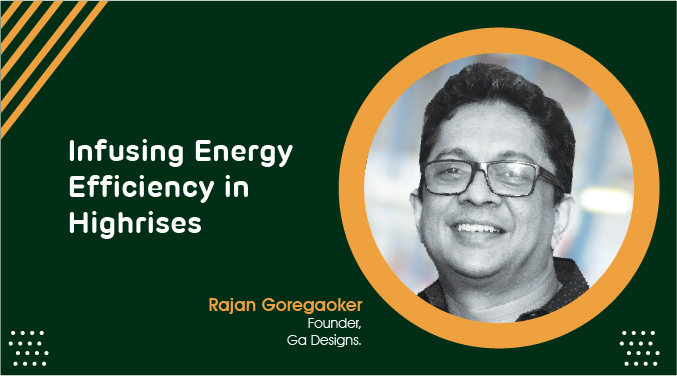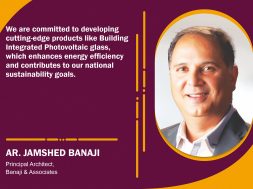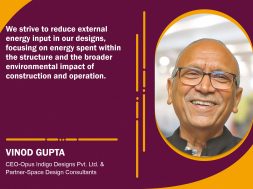Infusing Energy Efficiency in Highrises

Rajan Goregaoker, Founder of Ga Designs, speaks on how high-rise structures can be energy efficient by infusing solar panels on building façades. The glass itself acts as a solar energy generator.
What are the significant considerations we need to note as we scale higher and higher?
We always consider the necessity to look at how one (resident) can reach their apartment. There is always a certain time difference when you travel in the lift in high-rise buildings. So it’s very important that you have to look at technology which will give you a very efficient mode of vertical transport. We generally look at high-speed lifts. Usually, you’ll be looking at two and a half metres per second but here, its 4 metres per second. When you’re looking at a high rise, you have to make sure that the entire system functions in a very efficient manner. Eventually, it is not just about making a tall edifice, but it is about understanding that there are residents who will be residing in that building. Also, security, because as you go up, you have to ensure the windows are constructed very sturdy. If you’re using glass railing or if you are using balconies, you have to make sure that the system in place can withstand the air pressure. They have to be very secure and strong to ensure no untoward accidents occur. Building a high-rise is not just about making a great tower. There is a natural science to it which must be considered carefully so that the entire system functions efficiently.
What should be done to ensure that the entire construction phase of the high-rise and the design abides by sustainability?
During the construction phase, you’re always looking at the surrounding environment, and you’re looking at the inhabitants around the building. They should not be disturbed, and there shouldn’t be any untoward discomfort. We have different forms of construction. We are now using ALUFORM or Mivan, where you complete a
floor in 7 days. Time is of the essence, and with that kind of construction, you can finish the project in time. This also helps the environment and the society around you, so there is less disturbance for the neighbours. When high-rise buildings are built, it is essential to use materials that are not too reflective, which might cause a particular heat pocket around a building. Using a lot of reflective glass will create a lot of heat around the building, which is not suitable for the environment. You also don’t want to make a building that would block the wind stream, and you want to build a structure which is little transparent so that it doesn’t create a kind of micro-climate around it which is harmful to the neighbours around. Looking at all these aspects when building a high rise is essential.
What critical contemporary materials and technologies play an essential role in high-rise construction?
As mentioned earlier, you are looking at efficient construction technology for cost and time. So you’re looking at buildings where you can construct every floor in 7 days, where the curing period is not that long when you’re looking for high-grade concrete which makes a building. You’re also looking at technology where the formwork of the
entire building, which is the skeleton of the building, into which the concrete is poured. The entire system of designing buildings has changed. Now when we create a structure, the whole formwork is made before the construction comes on site and then it’s just a matter of fitting the plates together, and you can construct each floor along with the walls. There’s another technology, like the electrical services that go into the building. In a high-rise building, you have a whole nature of systems different
from conventional buildings. Electrical systems change, and meter reading rooms are provided on each floor instead of one-meter room to reduce the cost of wiring. The window systems are different because they have to cater to the wind pressure, so the windows are thicker and don’t rattle with the wind. We always ensure that whatever space you have, like the terraces, we use the space for solar technology. So you have a solar panel on top of the building, and the common lighting for the entire building is taken care of by solar power. The maintenance cost per resident goes down.
There are sewage systems where the sewage is recycled for these buildings, which is a must in all large projects. After the sewage is treated, it gives you waste water which is used for irrigation of the plants for the landscape. So all these things are part of making high-rise buildings. High-rise buildings reduce your footprint on the project. You get more area on the ground to use for amenities for the residents, which is very important because when you’re constructing a high rise, you’re creating a micro-city out there. Many people stay on one patch of land, so apart from the building, you have to have all these other facilities that people can use for recreation or landscape or trees, so when you go for a high rise, your footprint reduces. You have the advantage of using the land around you for all these reasons.
How are facades aiding the energy efficiency and aesthetics of high rises?
Some high-rise buildings have solar panels infused with the building façade, so the glass itself acts as a solar energy generator, with solar cells embedded in the glass. This technology is costly and not available in our country. As far as commercial buildings go, there is a lot of growth in technology with the use of performance glass. This glass cuts the solar heat gain in your office area, directly reducing conditioning costs. Technology like performance glass in buildings, commercial and residential, definitely increases efficiency and lowers electrical power consumption.
26
Cookie Consent
We use cookies to personalize your experience. By continuing to visit this website you agree to our Terms & Conditions, Privacy Policy and Cookie Policy.









